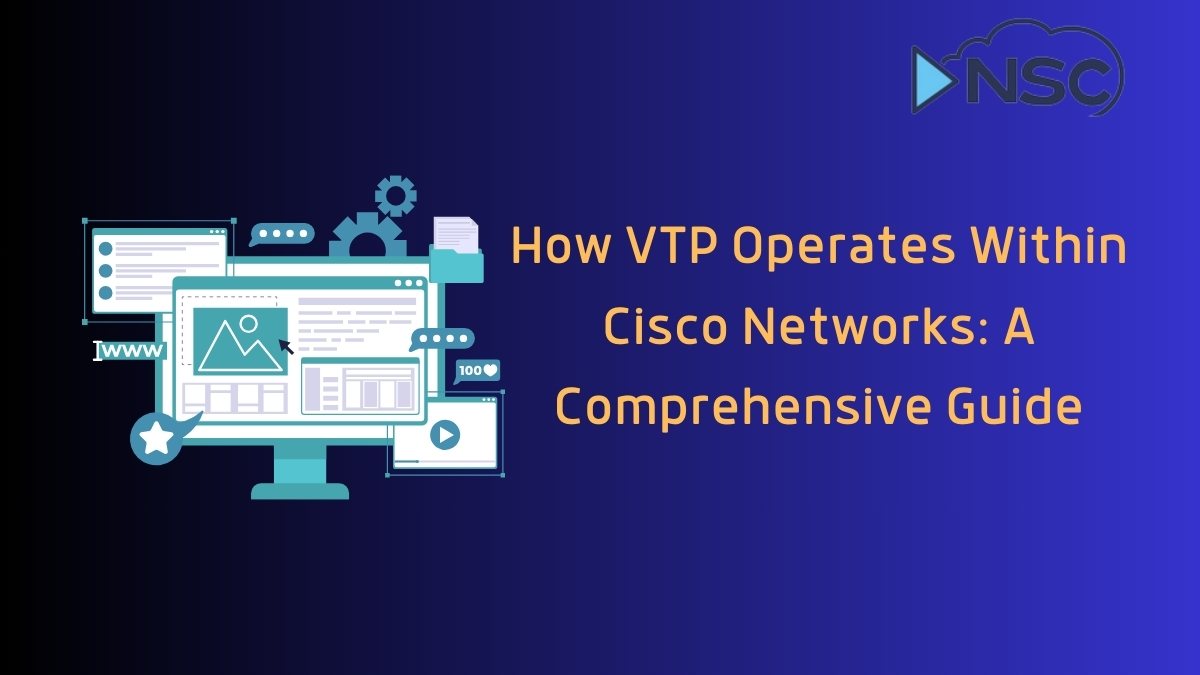VLAN Trunking Protocol (VTP) is a crucial component in the management of VLAN configurations across Cisco networks. Understanding VTP is essential for network engineers to efficiently deploy and manage VLANs, ensuring network stability and security. This guide provides an in-depth look into how VTP functions, the different versions and modes available, and the advanced features such as VTP pruning and authentication.
We'll explore the various aspects of VTP, including:
- The basic operation of VTP and how it simplifies network management.
- Comparison and features of different VTP versions.
- VTP modes and their specific roles within a network environment.
- Advanced configurations, such as pruning and authentication, to enhance network efficiency and security.
By the end of this guide, you’ll have a thorough understanding of VTP’s role in Cisco networks, equipped with practical knowledge on configuring and troubleshooting VTP-related issues.
What is VTP?
VTP (VLAN Trunking Protocol) is essential for managing the distribution of VLAN configuration across a network of switches. It reduces administrative overhead and ensures consistent configurations across all switches in a VTP domain by automating the propagation of VLAN changes.
To ensure optimal performance and security in your network, understanding the intricacies of Advanced VTP Configurations is essential. Visit our guide to explore advanced techniques for managing and deploying VLANs effectively.
- Purpose: VTP maintains consistent VLAN configuration across a network to prevent discrepancies and potential network issues.
- Operation: Updates made on a VTP server are automatically sent to all other switches in the domain, updating their VLAN configurations to match.
VTP Operation
The operational mechanics of VTP are crucial for fully leveraging its capabilities. It involves synchronization and advertisement of VLAN information:
- Synchronization: Ensures all switches in the VTP domain have the latest and consistent VLAN information.
- Advertisements: VTP servers send out VLAN information updates either every five minutes or immediately after any VLAN changes to keep all switches in the domain synchronized.
VTP Versions
VTP has undergone several updates, each version offering new features and improvements for better VLAN management.
- VTP Version 1: Focuses on basic VLAN propagation within the range of VLANs 1 to 1005.
- VTP Version 2: Adds support for Token Ring VLANs and improves the handling of unknown TLVs, enhancing network configurations.
- VTP Version 3: Offers extensive features like support for extended range VLANs, private VLAN propagation, and enhanced authentication mechanisms. It also introduces primary and secondary server roles for better VLAN management security.
Configuration and Management
Proper configuration of VTP is vital for its operation:
- Setting Up: Involves defining a VTP domain, selecting a mode, and setting the version to define how switches handle VLANs and VTP advertisements.
- Managing Revisions: Utilizes configuration revision numbers to ensure all switches in the domain synchronize to the latest VLAN configuration, accepting updates only with higher revision numbers.
VTP Modes and Their Functions
Different VTP modes allow for customized network behavior to meet specific needs.
- Server Mode: Allows switches to create, modify, and delete VLANs, and propagate these changes across the network.
- Client Mode: Switches receive updates from VTP servers and synchronize their VLAN configuration without the ability to alter it.
- Transparent Mode: Switches do not participate in the VTP domain but can forward VTP advertisements through trunk links, useful for administrative network segmentation.

Advanced VTP Features
VTP Pruning
VTP pruning enhances network efficiency by reducing unnecessary flood traffic. It restricts flooded traffic on trunk links leading to switches that do not have members in specific VLANs. This selective forwarding helps conserve bandwidth and reduces unnecessary load on network devices.
- Purpose: To optimize the use of network resources by minimizing broadcast, unknown unicast, and multicast (BUM) traffic.
- Configuration: Involves enabling pruning on a VTP server, which then propagates the setting to all VTP clients within the domain.
VTP Authentication
Security in VTP is crucial to prevent unauthorized changes to VLAN configurations. VTP supports enhanced authentication mechanisms to secure VLAN management across the network.
- Authentication Process: Utilizes a secret password that is hashed using the MD5 algorithm. This password must be configured identically across all switches in the VTP domain to authenticate and accept updates.
- Benefits: Prevents unauthorized access to VTP configurations and ensures that only trusted sources can modify VLAN information.
Troubleshooting and Common Issues
Common VTP Issues
Even with a robust protocol like VTP, issues can arise that may disrupt network operations. Understanding common VTP-related problems helps in quick diagnosis and resolution.
- Revision Number Mismatches: One of the most common issues where switches in the same VTP domain have different configuration revision numbers, leading to synchronization problems.
- Incorrect VTP Mode Settings: Problems occur when switches are not correctly set in the intended VTP mode, leading to unexpected behaviors.
Best Practices for VTP Management
Effective management and monitoring of VTP can mitigate potential issues and enhance network reliability.
- Regular Backups: Always keep backups of VLAN configurations to recover quickly from potential mishaps.
- Careful Change Management: Monitor changes in VTP configurations closely and understand the impact before implementing them network-wide.
- Use of VTP Version 3: Whenever possible, use VTP version 3 for its enhanced security features and support for extended VLANs.
Summary
VTP (VLAN Trunking Protocol) is an indispensable tool for efficient management of VLAN configurations across Cisco networks. By leveraging features like VTP pruning and VTP authentication, network administrators can significantly enhance both network efficiency and security.
Understanding and utilizing the full capabilities of VTP ensures that VLAN configurations are consistently managed and synchronized across all switches in the domain, reducing administrative overhead and potential for errors.
Regular monitoring and adherence to best practices are crucial in leveraging the full potential of VTP. By staying informed of the latest developments and maintaining rigorous management protocols, organizations can ensure a robust and secure network infrastructure. As networks grow and change, the role of tools like VTP in maintaining network integrity will only increase in importance.


